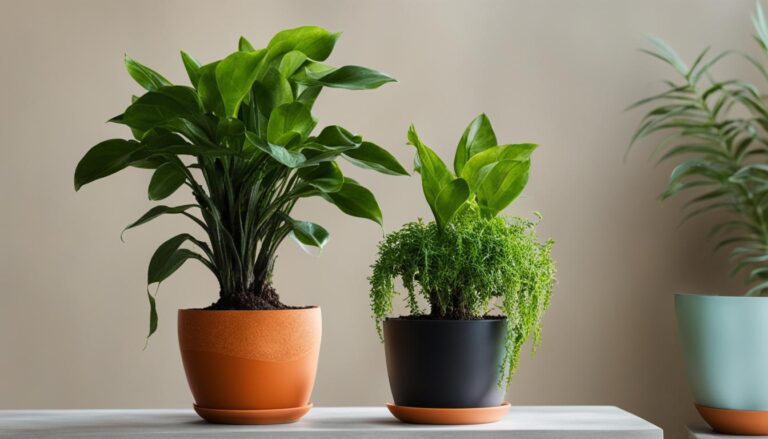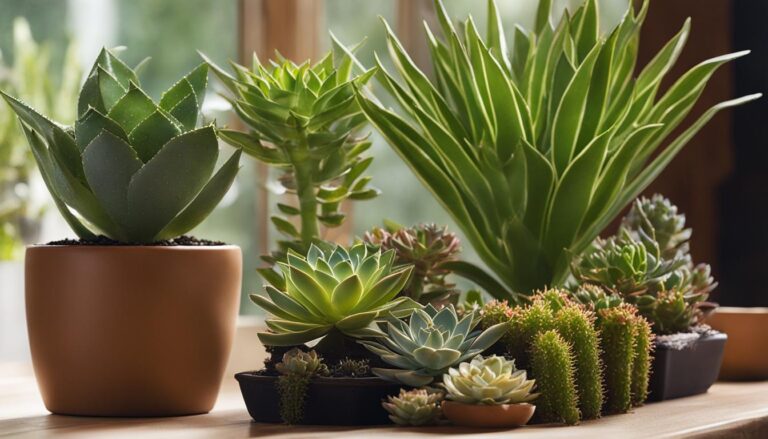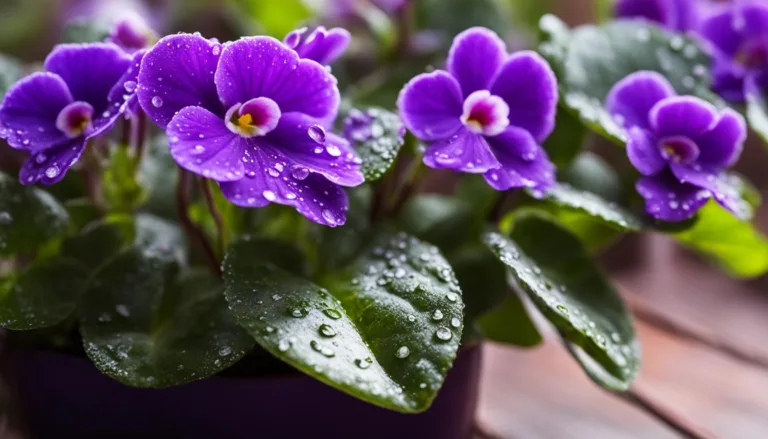
Welcome to my guide on growing and caring for coffee plants! If you’re a coffee lover like me, why not try your hand at cultivating your very own coffee beans at home?
In this article, we’ll explore the essential tips and techniques for successfully growing coffee plants, whether indoors or outdoors. From providing the right growing conditions to harvesting your own beans, you’ll soon be savoring the fruits of your labor in a steaming cup of freshly brewed coffee.
Key Takeaways:
- Growing coffee plants at home is a rewarding experience for coffee enthusiasts.
- Indoor coffee plant care requires good drainage, high humidity, and slightly acidic soil.
- Outdoor coffee plant care also involves providing the right amount of sunlight and temperature.
- Regular watering and fertilizing are crucial for the healthy growth of coffee plants.
- Harvesting and processing coffee beans require patience and proper techniques.
Native Habitat and Growth Habits
Coffee plants, originally from Ethiopia, thrive in their native habitat as medium-sized trees. In their natural environment, they can grow up to two feet within the first year and continue to grow rapidly if left unpruned. However, when grown indoors, coffee plants are typically pruned to maintain a more manageable size.
It usually takes about three to five years for indoor coffee plants to start bearing fruits. Once mature, these plants can produce up to 4,000 coffee beans annually, resulting in about one pound of coffee grounds. With a lifespan of 30 to 40 years, coffee plants offer ample opportunities for coffee production.
To visualize the growth habits of coffee plants, here’s a table showcasing their native habitat and indoor growth characteristics:
| Native Habitat | Indoor Growth | |
|---|---|---|
| Size | Medium-sized trees | Pruned for manageability |
| Growth Rate | Rapid | Slower indoors |
| Time to Fruit | Varies, usually 3-5 years | 3-5 years |
| Annual Yield | Up to 4,000 coffee beans | Up to 4,000 coffee beans |
| Lifespan | 30-40 years | 30-40 years |
Growing Conditions for Coffee Plants
When it comes to growing coffee plants, providing the right conditions is crucial for their health and productivity. To ensure optimal growth, coffee plants require specific environmental factors such as sunlight, soil pH, and watering needs.
Sunlight Requirements
Coffee plants thrive in bright but indirect sunlight. Placing them near a window that receives filtered sunlight is ideal. Direct sunlight can scorch the leaves, so it’s important to protect them from intense rays. If you notice browning or yellowing leaves, it may be a sign that your coffee plant is receiving too much sun and needs to be moved to a shadier location.
Soil pH
The pH level of the soil is crucial for coffee plants. They prefer slightly acidic soil with a pH range of 6 to 6.5. To ensure the right pH, you can use a soil testing kit to monitor the acidity. If the soil is too alkaline, you can adjust it by adding organic matter like compost or peat moss to increase acidity.
Watering Needs
Coffee plants require regular and consistent watering to keep the soil moist. It’s important to avoid overwatering as it can lead to root rot and other issues. A good rule of thumb is to water your coffee plant when the top inch of soil feels dry to the touch.
Water thoroughly, allowing excess water to drain out from the bottom of the pot. Remember, coffee plants prefer well-draining soil to prevent waterlogging.
| Growing Condition | Requirements |
|---|---|
| Sunlight | Bright, indirect sunlight |
| Soil pH | Slightly acidic (6-6.5) |
| Watering | Regular, moist soil but not waterlogged |
By providing the right growing conditions, you can ensure the health and well-being of your coffee plants. Remember to monitor sunlight exposure, maintain the proper soil pH, and water consistently to enjoy thriving coffee plants and a potential bountiful harvest.
Types of Coffee Plants
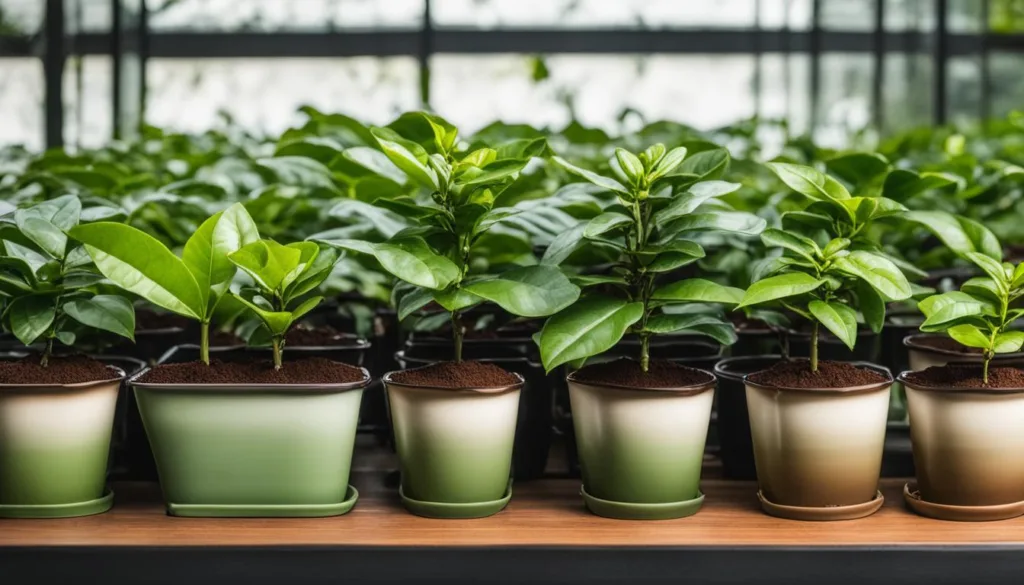
Coffee plants come in various varieties, each with its own unique characteristics and flavor profiles. The most popular type of coffee plant is Coffea arabica, which is known for its high-quality beans and delicate flavor.
Arabica coffee plants are typically grown at higher altitudes and require a cooler climate to thrive. They have a lower caffeine content compared to other varieties, making them a popular choice among coffee connoisseurs.
Another common variety is Coffea robusta, also known as Canephora. Robusta coffee plants are more resilient and have a higher caffeine content, resulting in a stronger and more bitter taste compared to Arabica beans.
The beans produced by Robusta plants are often used in instant coffee and espresso blends due to their bold flavor and higher caffeine levels. Robusta plants are also easier to grow and more resistant to pests and diseases, making them a popular choice for commercial coffee production.
For those seeking a caffeine-free alternative, there is Coffea charrieriana. This unique variety of coffee plant naturally produces beans that are free of caffeine. It is a rare and sought-after type of coffee for those who are sensitive to caffeine or prefer to avoid it.
Although caffeine-free coffee plants are not as widely cultivated as Arabica and Robusta varieties, they offer a unique option for coffee enthusiasts.
Coffee Plant Varieties Comparison
| Variety | Flavor | Caffeine Content | Growth Conditions |
|---|---|---|---|
| Arabica | Delicate | Low | Higher altitudes, cooler climate |
| Robusta | Strong, bitter | High | Lower altitudes, warmer climate |
| Caffeine-free | N/A (caffeine-free) | None | Similar to Arabica |
These are just a few examples of the many coffee plant varieties available. Each variety has its own unique characteristics and is influenced by the climate, soil conditions, and processing methods.
Whether you prefer a mild and aromatic cup of Arabica coffee or a bold and robust Robusta blend, exploring the different types of coffee plants can add a whole new dimension to your coffee experience.
Planting and Repotting Coffee Plants
Planting and repotting coffee plants is an essential aspect of caring for these beautiful indoor specimens. Whether you are starting with a young seedling or need to give your mature plant a fresh home, understanding the right techniques and materials is crucial for their well-being.
Planting Coffee Plants
When planting coffee plants, it’s important to choose the right potting soil and pot size. Coffee plants thrive in rich, peat-based potting soil that provides excellent drainage.
This helps prevent waterlogged roots and potential rot. The ideal soil pH for coffee plants is slightly acidic, around 6 to 6.5. Look for potting soil specifically formulated for acid-loving plants or create a mix of peat moss, perlite, and compost.
When it comes to pot size, start with a small container that allows for adequate root development. As the plant grows, you’ll need to repot it into larger containers. Choose pots with multiple drainage holes to ensure proper water flow and prevent waterlogging.
Repotting Coffee Plants
Repotting coffee plants should be done annually during the spring season. As the plant grows, it outgrows its current pot and requires more space for root development.
Gradually increase the pot size each time you repot, allowing the plant to adjust to its new container size. This helps prevent stress and allows for better nutrient uptake.
During the repotting process, you can also prune the roots slightly to encourage healthy growth. Remove any dead or decaying roots and trim any excessively long ones.
| Planting and Repotting Coffee Plants | Key Points |
|---|---|
| Potting Soil | Rich, peat-based soil with excellent drainage |
| Pot Size | Start small and gradually increase as the plant grows |
| Repotting Frequency | Annually during spring |
| Root Pruning | Trim dead or decaying roots during repotting |
By following proper planting and repotting techniques, you can ensure that your coffee plant has the right environment to thrive and produce beautiful foliage and, eventually, coffee cherries.
Watering and Feeding Coffee Plants
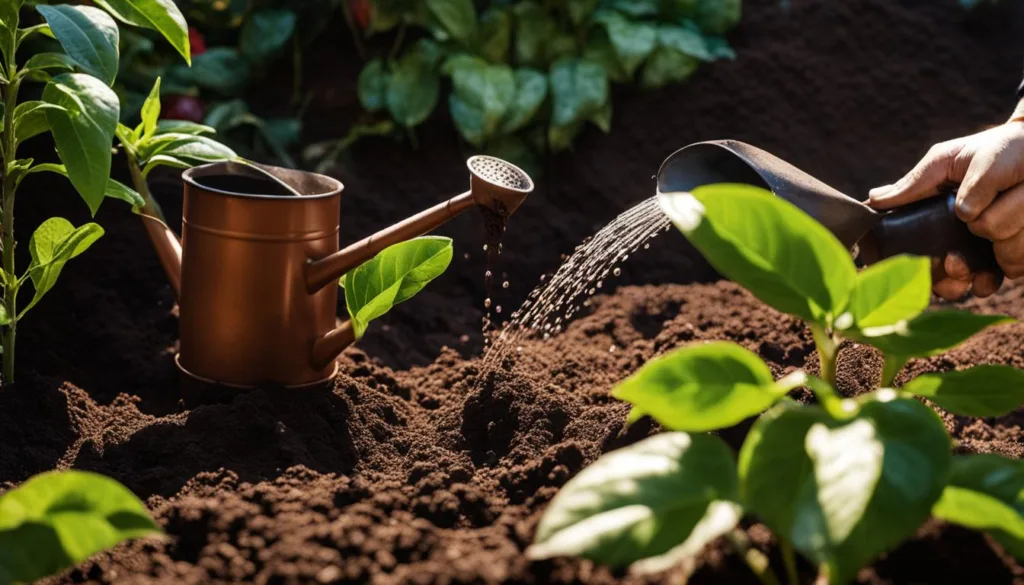
When it comes to caring for coffee plants, proper watering and feeding are essential for their health and productivity. Here are some tips to help you keep your coffee plants thriving:
Watering Tips
- Water the plants enough to keep the soil evenly moist throughout.
- Check the soil regularly and water again every 1 to 2 weeks when it starts to dry out halfway.
- Avoid overwatering, as it can lead to root rot. Ensure good drainage to prevent waterlogging.
Feeding Schedule
- During the growing season, feed your coffee plants regularly with a weak liquid fertilizer every couple of weeks.
- Choose a fertilizer specifically formulated for acid-loving plants.
- In winter, reduce the frequency of fertilizing to about once a month.
Proper watering and regular feeding will provide your coffee plants with the necessary nutrients to thrive and produce healthy foliage and coffee beans. Remember to adjust your watering and feeding routine based on the specific needs of your plants and the environmental conditions they are exposed to.
| Watering Tips | Feeding Schedule |
|---|---|
| – Water the soil evenly – Check regularly and water every 1-2 weeks – Avoid overwatering and ensure good drainage | – Feed regularly during the growing season – Use a weak liquid fertilizer every 2 weeks – Choose a fertilizer for acid-loving plants – Reduce frequency to once a month in winter |
By following these watering tips and feeding schedule, you can provide your coffee plants with the ideal conditions for growth and development. Remember that each plant may have slightly different needs, so it’s important to observe and adjust accordingly. With proper care, your coffee plants will reward you with healthy foliage and the potential to enjoy your own homegrown coffee.
Pruning and Propagation of Coffee Plants
Pruning is an essential aspect of coffee plant care, as it helps maintain the plant’s shape and promotes bushier growth. When pruning your coffee plant, focus on removing any dead or diseased branches, as well as any crossing or crowded branches. This will improve airflow and sunlight penetration, reducing the risk of pests and diseases.
To propagate your coffee plant, you have two common methods: using cuttings or air layering. Taking cuttings involves selecting a healthy stem, cutting it just below a leaf node, and removing any lower leaves.
Plant the cutting in a small pot with soilless potting mix, ensuring it is kept slightly moist until roots form. Air layering is a more complex technique that involves creating a wound on a healthy branch, treating it with a rooting hormone, and wrapping it with moist sphagnum moss. Over time, roots will develop, and the branch can be cut and planted separately.
Pruning Coffee Plants
When pruning your coffee plant, follow these steps:
- Start by sterilizing your pruning tool with rubbing alcohol to prevent the spread of diseases.
- Carefully remove any dead or diseased branches, cutting them back to healthy tissue.
- Trim any crossing or crowded branches to improve airflow and sunlight penetration.
- Inspect the plant for suckers (vigorous shoots) growing from the base, and if desired, leave one or two to promote a bushier growth habit.
- Lastly, shape the plant to your desired form, taking care not to remove more than one-third of the overall growth.
Propagating Coffee Plants
If you wish to propagate your coffee plant, there are two common methods:
- Cuttings: Select a healthy stem and cut it just below a leaf node. Remove any lower leaves, dip the cut end in rooting hormone, and plant the cutting in a small pot with soilless potting mix. Keep the soil slightly moist until roots form.
- Air Layering: Choose a healthy branch and make a 1-inch wound just below a node. Apply rooting hormone to the wound, and wrap it with moist sphagnum moss. Keep the moss moist, and after a few weeks to months, roots will develop. Cut the branch below the rooted area and plant it separately.
Common Pests and Diseases of Coffee Plants
While growing coffee plants can be a rewarding experience, it’s important to be aware of the common pests and diseases that can affect them. By familiarizing yourself with these issues, you can take proactive steps to prevent and control them, ensuring the health and productivity of your coffee plants.
Pests:
- Mealybugs: These small insects can infest coffee plants, feeding on the sap and causing damage to the foliage. In severe cases, they can weaken the plant and inhibit its growth. Regular inspection and early detection are key to controlling mealybug infestations.
- Aphids: Aphids are another common pest that can attack coffee plants. They reproduce rapidly and can cause damage by sucking the sap from the leaves, resulting in distorted growth and yellowing foliage.
- Mites: Spider mites are tiny pests that can be challenging to detect. They feed on the undersides of the leaves, causing discoloration and a stippled appearance. If left untreated, mite infestations can weaken the plant and affect its overall health.
Diseases:
- Leaf Spot: Leaf spot is a fungal disease that can affect coffee plants, causing brown spots on the leaves. It is usually caused by excessive moisture and poor air circulation. Pruning affected leaves and improving ventilation can help prevent the spread of this disease.
To control pests and diseases, it is important to maintain good plant hygiene and provide appropriate growing conditions. Regularly inspect your coffee plants for signs of infestation or disease and take immediate action to prevent further spread.
Organic treatments such as neem oil can be effective in controlling pests, while proper watering techniques and adequate air circulation can help prevent disease.
Troubleshooting Common Issues with Coffee Plants
While coffee plants can be a rewarding addition to your indoor garden, they can sometimes encounter issues that may affect their health and growth. By understanding common problems and their solutions, you can effectively troubleshoot and ensure the well-being of your coffee plants.
Leaf Browning
One common issue with coffee plants is leaf browning, which can be caused by various factors. Excessive sunlight can scorch the leaves, resulting in brown patches.
To combat this, it’s important to provide more indirect light by moving the plant away from direct sunlight. Additionally, browning leaves can also signal a lack of humidity. Consider misting the plant or using a humidifier to provide the necessary moisture.
Leaf Scorch
Similar to leaf browning, leaf scorch is another problem that coffee plants may face. It occurs when the leaves are exposed to too much sun, resulting in dried and browned edges.
To address this issue, it’s crucial to provide the plant with more indirect light. Moving it to an east-facing window can help prevent leaf scorch and promote healthy foliage.
Lack of Blooms
If your coffee plant is not producing blooms, the primary culprit is often insufficient light. Coffee plants require bright indirect light to stimulate blooming. Consider moving your plant to a more well-lit area, such as an east-facing window, to provide the energy it needs for flower production. By ensuring adequate light exposure, you can encourage your coffee plant to produce beautiful blooms.
| Common Issues | Possible Solutions |
|---|---|
| Leaf Browning | Provide more indirect light and increase humidity. |
| Leaf Scorch | Move the plant to a location with more indirect light. |
| Lack of Blooms | Ensure the plant receives bright indirect light. |
Harvesting and Processing Coffee Beans
Once your coffee plants have matured and produced bright crimson cherries, it’s time to harvest and process the coffee beans. Harvesting can be a labor-intensive process, especially if you have multiple plants. Pick the cherries when they are fully ripe, as this ensures optimal flavor and aroma in the beans.
To process the beans, start by removing the fruit flesh. This can be done by hand or using a pulping machine. After pulping, the beans need to be thoroughly washed and then dried. You can spread them out on a flat surface or use a drying rack. It’s important to dry the beans completely to prevent mold or fermentation.
Once the beans are dry, they can be stored in a cool, dry place until you’re ready to use them. When you’re ready to enjoy your homegrown coffee, you’ll need to roast the beans. This can be done using a coffee roaster or even a popcorn popper. Experiment with different roast levels to find your preferred flavor profile.
| Harvesting and Processing Coffee Beans |
|---|
| Harvest cherries when bright crimson |
| Remove fruit flesh and wash beans |
| Dry beans thoroughly |
| Store beans in a cool, dry place |
| Roast beans to desired flavor profile |
Now that you have your freshly roasted beans, it’s time to grind them and brew a cup of coffee. Grind the beans just before brewing to ensure maximum freshness. Choose a brewing method that suits your taste, whether it’s a French press, pour-over, or espresso machine. Sit back, sip, and savor the unique flavors of your very own homegrown coffee.
Summary:
- Harvest coffee cherries when they turn bright crimson.
- Remove the fruit flesh and wash the beans thoroughly.
- Dry the beans completely to prevent mold or fermentation.
- Store the beans in a cool, dry place until ready to use.
- Roast the beans to your desired flavor profile before grinding and brewing.
Enjoying Your Homegrown Coffee
Growing and caring for coffee plants has been an incredibly fulfilling journey for me. Not only do I get to enjoy the beauty of these plants in my home, but I also have the pleasure of brewing my own coffee from homegrown beans. There’s something magical about sipping a cup of coffee that I nurtured from seed to harvest.
Brewing coffee from homegrown beans adds an extra layer of satisfaction to my morning routine. I carefully harvest the bright crimson cherries, remove the fruit flesh, and dry the beans to perfection. Once roasted and ground, the aroma fills the air, and I know that I’m about to enjoy a unique and flavorful cup of homemade coffee.
There’s a sense of pride that comes with being able to grow and brew my own coffee. It’s a reminder of the connection I have with nature and the joy that can be found in the simple pleasures of life.
So, if you’re considering growing coffee plants at home, I encourage you to take the leap. Embrace the journey, nurture your plants, and savor the rewards of a cup of coffee made from your very own homegrown beans.
FAQ
How long does it take for a coffee plant to start producing fruits indoors?
It takes about three to five years for a coffee plant to start producing flowers and fruits indoors.
How much coffee grounds can a coffee plant produce annually?
Each coffee plant can produce about 2,000 coffee cherries annually, resulting in around one pound of coffee grounds.
How long can a coffee plant live?
Coffee plants can live up to 30 to 40 years.
What are the specific growing conditions required for coffee plants?
Coffee plants require good drainage, high humidity, cool temperatures, and slightly acidic soil.
What are the different varieties of coffee plants?
There are varieties such as Arabica, Robusta, Liberica, and Charrieriana. The Arabica variety is the most common and produces high-quality beans with a delicate flavor.
What type of soil is best for growing coffee plants?
Coffee plants should be planted in rich, peat-based potting soil with excellent drainage. The ideal soil pH for coffee plants is around 6 to 6.5, slightly acidic.
How often should I water my coffee plant?
Coffee plants should be watered enough to keep the soil evenly moist, watering again every 1 to 2 weeks when the soil starts to dry out halfway.
How can I propagate coffee plants?
Coffee plants can be propagated through cuttings or air layering. Cuttings should be taken in the early summer, and air layering is a more involved technique where branches are rooted while still attached to the parent plant.
What pests and diseases can affect coffee plants?
Coffee plants can be affected by pests like mealybugs, aphids, and mites, as well as fungal diseases like leaf spot. Proper care and control measures can help prevent infestations and diseases.
Why are the leaves of my coffee plant turning brown?
Brown leaves on a coffee plant can be caused by excessive sunlight or root rot due to overwatering. Adjusting the lighting conditions or watering frequency can help resolve this issue.
When and how should coffee beans be harvested?
Coffee beans should be harvested when they turn bright crimson in color. The fruit flesh should be removed, and the seeds or beans should be thoroughly dried before planting or roasting.
How can I enjoy my homegrown coffee?
Roast the beans before grinding to bring out the unique flavors and aromas. Follow proper brewing techniques to enjoy a freshly brewed cup of coffee made from your homegrown beans.

